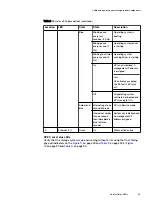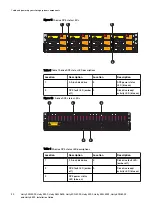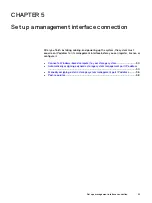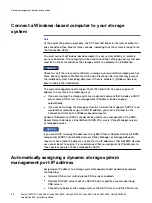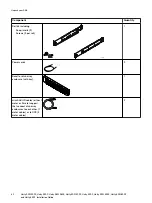
Connect a Windows-based computer to your storage
system
Note
At the end of the power-up process, the SP Fault LED blinks in intervals of amber for
one second and then blue for three seconds, indicating that the system is ready to run
the Connection Utility.
You must connect a Windows-based computer to your system directly or remotely
over a subnetwork. This computer will be used to continue setting up your system and
must be on the same subnet as the storage system to complete the initialization.
NOTICE
Check to see if there is security software running on your workstation/laptop such as
Cisco Security Agent or McAfee Host Intrusion Prevention Service that may prevent
the initialized system from being detected. If there is, disable it (Windows Services)
before running the initialization.
The system management ports support both IPv4 and IPv6. You can assign an IP
address to a system in the following ways:
l
If you are running the storage system on a dynamic network that includes a DHCP
server and a DNS server, the management IP address can be assigned
automatically.
l
If you are not running the storage system in a network that supports DHCP or you
would rather manually assign a static IP address, you must install and run the
Connection Utility on the Windows-based computer.
Dynamic IP addresses (DHCP) should not be used for any components of the EMC
Secure Remote Services Virtual Edition (ESRS VE) servers, Policy Manager servers,
or managed devices.
NOTICE
If you use DHCP to assign IP addresses to any EMC Secure Remote Services (ESRS)
components (ESRS Virtual Edition servers, Policy Manager, or managed devices),
they must have static IP addresses. Leases for the IP addresses that Dell EMC devices
use cannot be set to expire. It is recommended that you assign static IP addresses to
those devices you plan to have managed by ESRS.
Automatically assigning a dynamic storage system
management port IP address
Assigning an IP address to a storage system management port dynamically requires
the following:
l
Network DNS server (with dynamic DNS services enabled)
l
Network DHCPv4 server and/or a DHCPv6 server and/or a router advertising
DNS servers
l
Connectivity between the storage system, the DHCP server, and the DNS server
Set up a management interface connection
34
Unity 300/300F, Unity 350F, Unity 380/380F, Unity 400/400F, Unity 450F, Unity 500/500F, Unity 600/600F
and Unity 650F
Installation Guide










